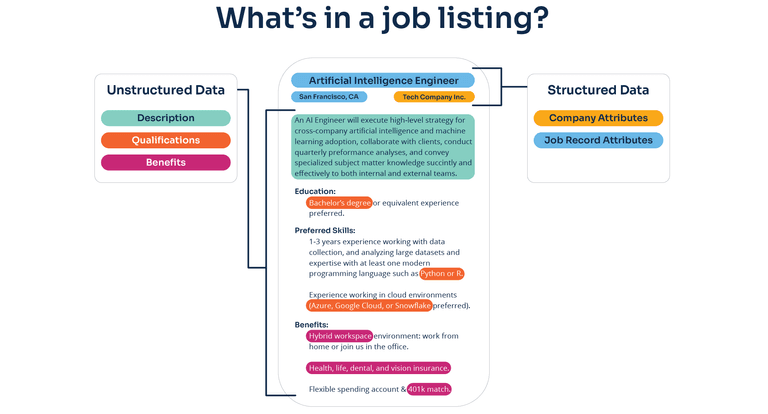What’s in a Job Listing? The LinkUp Difference
Understanding what’s in a job listing and applying that knowledge to LinkUp’s job market data is an invaluable resource. It can forecast economic growth, identify industry trends, map geographic activity, and more.

What is a job listing? At the simplest level, it’s how a company recruits new applicants for an open position. But for those of us interested in alternative data, it’s much, much more than that.
When a company posts a new job, it’s envisioning and planning for its future. It implies certain essential questions about the company: is it maintaining, shrinking, or growing? Where in the world is the company working? And in what way–remote, in-office, or hybrid? What skills does it hold in high demand? How quickly is it hiring? To answer these questions, LinkUp collects over 30 unique job- and company-level data points from the text of every job listing we index, including company name, posting date, location, salary range, education and experience requirements, qualifications, soft and hard skill requirements, and benefits.

Handled properly, every job listing becomes a trove of inherently forward-looking information that can tell us all kinds of things about where a single company–or at scale, an entire industry, even the global economy–is moving. So, really, you can think of any job listing as a window–a uniquely predictive view into the inner-workings of the job market, the largest market on earth.
But if the window’s cloudy, you can’t trust what you see through it; if you want to harness the power of job listing data, it simply must be accurate. Without reliable data, job market analysis is smoke and mirrors. A house built on a fairy’s wing.
In recent posts, we’ve enumerated the sources of job data pollution on job boards and the inflated and false signal they generate. The inaccuracies built into the job board model gave rise to our unique approach to data quality at LinkUp: we scrape job listings directly from their source, company websites, where each listing corresponds to a real job. When a company posts a job on their website, it is absolutely the clearest, strongest signal available in the world of that company’s intent to make a hire and fill that opening in the future. We index from over 60,000 websites every day, and have tracked more than 250 million listings in our dataset since 2007. See, pulling from the source isn’t new to us. It’s in our company’s DNA.
We set out in 2009 with a singular focus: to build the best job search engine in the world. Back then we were known as JobDig, and our competitors were the emerging online job boards and the thousands of daily and weekly newspapers that fed on classified ad money. We knew that listings on either of these platforms were impossible to verify. Meanwhile, in the midst of the .com megasurge, companies had started posting job listings to a buzzy new interface–their own websites. A Eureka moment! We knew instantly that this was the gold standard for job postings on the web; when you see a job on Nike’s website, you know that it’s a Nike job.
Our first major clients were actually job boards. They knew better than anyone that their listings were trashed by pollution and fraud of every stripe. When Monster’s CEO summarized their new vision circa 2014 as “All the jobs and all the people,” they were able to claim “all the jobs” because of the job openings they were buying from us. In roughly the same era, Careerbuilder fed our data to a site they operated called—tellingly—“Betterjobs.com.”
Twenty-two years later, after spinning out, rebranding, and selling our pay-per-click job search engine (Getwork), LinkUp is focused solely on the data business, and today we furnish the world’s leading HR Tech companies, financial institutions, and corporations with the best quality job market data available anywhere.
With the world’s largest and most accurate dataset of job listings at our disposal, LinkUp offers clients scores of real world applications to improve their business.
In an ongoing series of posts, we’ll highlight our favorite use cases in detail. But to give you a sense of the depth and breadth of our offering, here are a few of the things that LinkUp job data can do:

Forecast Job Growth.
LinkUp’s proprietary forecasting model captures the correlation between job openings at a given time and job growth in a future period. We consistently beat out competitors and other forecasters in our estimates of monthly nonfarm payroll growth, illustrating the inherently predictive nature of accurate job listings.
Track the Future of Work.
By analyzing patterns in job descriptions across companies and industries at large, we get an advanced view of how today’s workplace is changing–is the work from home revolution tapering off? Which companies still offer fully remote positions? What aspects of corporate culture are gaining traction? Follow the job listings.
Measure Hiring Velocity.
As we track not just the raw text of job descriptions, but also the duration that listed jobs remain open on company sites before being filled, we can determine the speed at which companies are hiring over time. This measure illuminates the state of labor supply and demand and can inform decisions ranging from staffing negotiation to investment allocation.
Identify Tech Trends and Skills Demand.
As industries adopt new technologies, they’ll start hiring for candidates with core competencies therein. Users search our database by keyword to determine which companies and industries are plowing ahead in the 4th Industrial Revolution and which skills mark the ideal candidate of the future. Recently, CitiGroup leveraged our data to analyze the evolution of skills in the job market across all major sectors between the periods of 2014-2015 & 2018-2020.
Map Geographic Activity.
As each job listing includes a location (unless they’re fully remote), our data allows us to map job activity from the broadest view of national economies, right down to the granular precision of local zip codes. The possible uses of this intel are practically endless–it allows us to see, in real time, where the workforce is moving, what regions are diversifying, when a given real estate market is about to heat up, and much more.
Drill Down by Industry and Sector.
One of the strongest value adds that our data offers is a maximum capacity for customization. You can evaluate job data by industry, sector, occupation, geography; by keywords for skills, salary ranges, and competitive benefits. The richness of the dataset is a dream for quant analysts, macro thinkers, and human capital officers alike. There’s simply no better toolset for interpreting the labor market, whether you’re thinking broadly or zoomed all the way in.
It all returns to the question we began with: what is a job listing? At LinkUp, we know that every job listing is a promissory note with the future, illustrating today’s optimism or caution and projecting tomorrow’s growth. In the end, it tells us where the world of work is moving like nothing else can. To learn more about what LinkUp job data can do for you, contact us to schedule a demo or trial our data.
Job Board Data Pollution Blog Series:
Job Board Data Pollution: An Introduction
Job Board Data Pollution: The Nefarious Underworld of Fake Jobs (Part 1)
Job Board Data Pollution: How Duplication Bloats the Labor Market (Part 2)
Job Board Data Pollution: Expired Listings Slow Data Down (Part 3)
Insights: Related insights and resources
-
Blog
11.21.2023
Job Board Data Pollution: Expired Listings Slow Data Down (Part 3)
Read full article -
Blog
11.17.2023
Job Board Data Pollution: How Duplication Bloats the Labor Market (Part 2)
Read full article -
Blog
11.15.2023
Job Board Data Pollution: The Nefarious Underworld of Fake Jobs (Part 1)
Read full article
Stay Informed: Get monthly job market insights delivered right to your inbox.
Thank you for your message!
The LinkUp team will be in touch shortly.
